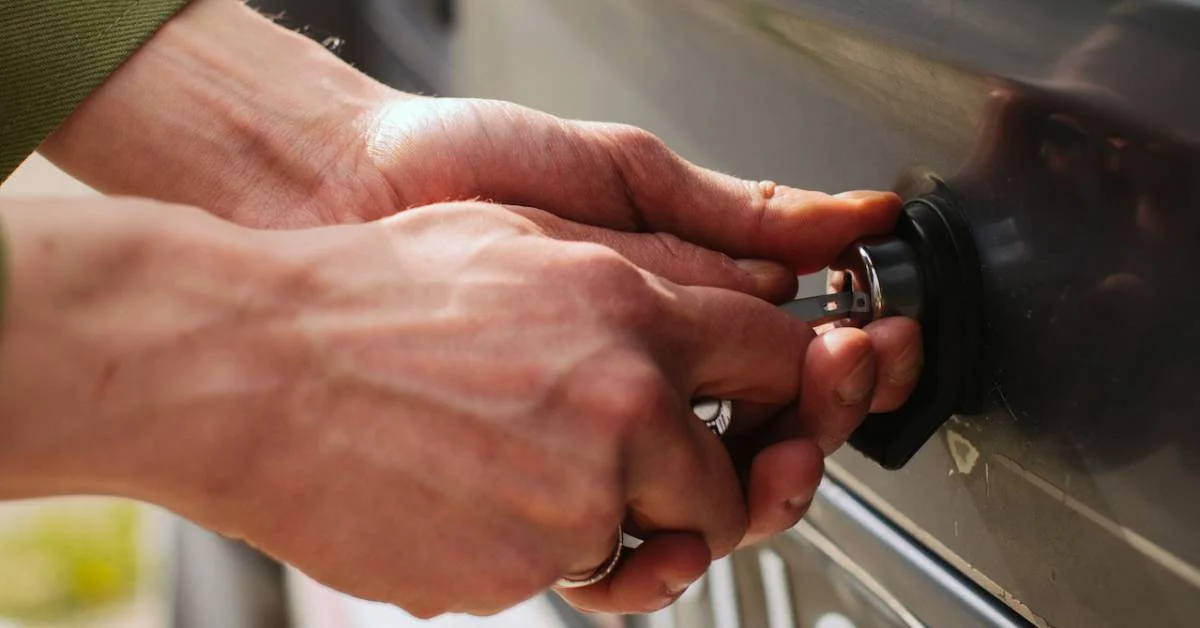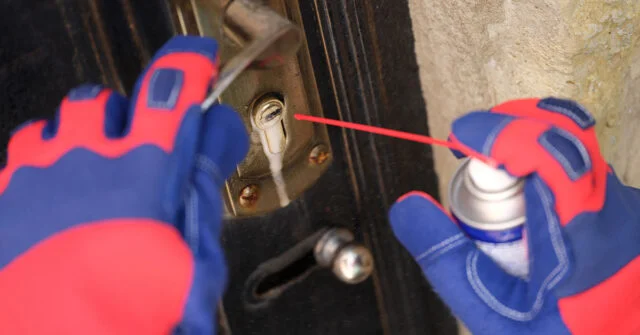Dealing with a stuck or jammed lock can be frustrating, especially if it’s preventing you from accessing your home, office, or vehicle.
In this comprehensive guide, we will walk you through the process of identifying, diagnosing, and repairing common lock issues.
We’ve tailored this guide specifically for the Australian market, so you can confidently handle lock problems with ease and know when it’s time to call a professional locksmith.
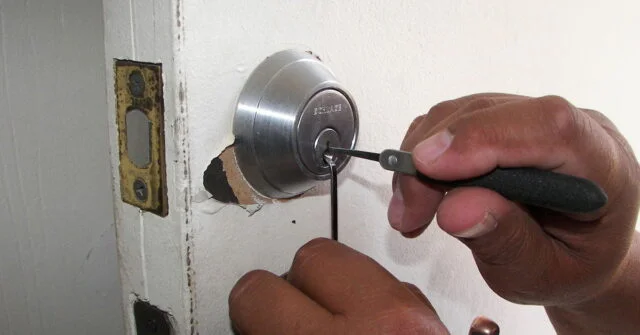

Understanding Locks and Common Issues
Before diving into the process of fixing a stuck or jammed lock, it’s essential to have a basic understanding of the different types of locks and the common issues that can occur.
This knowledge will help you diagnose and address the problem effectively.
Types of Locks in Australia
In Australia, you’ll come across various types of locks used in residential, commercial, and automotive applications. Some common lock types include deadbolts, knob locks, lever handle locks, and padlocks.
Additionally, electronic and smart locks are gaining popularity due to their advanced security features and convenience.
Familiarising yourself with these lock types will enable you to better understand the potential issues that may arise.
Common Causes of Stuck or Jammed Locks
There are several reasons why a lock may become stuck or jammed.
Some common causes include dirt and debris build-up, misaligned door components, damaged or worn keys, broken lock components, and extreme weather conditions.
By identifying the root cause of the problem, you can determine the most appropriate course of action for fixing the lock.
Preventative Maintenance for Locks
Regular maintenance is crucial in ensuring the longevity and proper functioning of your locks.
By following a few simple steps, you can help prevent many of the common issues that lead to stuck or jammed locks.
Regular Cleaning and Lubrication
Locks can accumulate dirt and debris over time, causing them to become difficult to operate.
Regularly cleaning your locks and applying a suitable lubricant, such as a graphite-based product, can help maintain smooth operation and prevent jams.
Avoid using oil-based lubricants, as they can attract dust and dirt, worsening the problem.
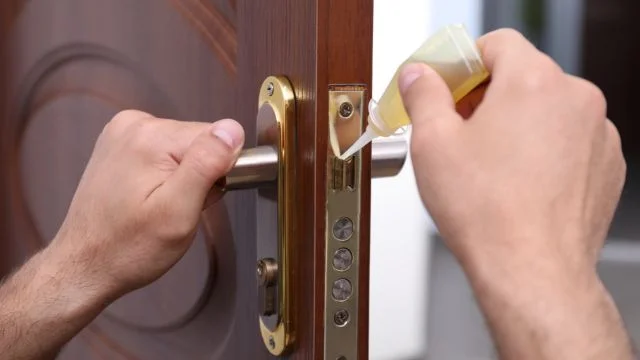

Proper Key Use and Care
Taking care of your keys is essential in preventing lock issues. Avoid using excessive force when turning the key, as this can lead to bent or broken keys and damaged lock components.
Also, ensure you’re using the correct key for the lock, as using the wrong key can cause it to become stuck.
Periodic Inspections and Repairs
Regularly inspect your locks for signs of wear and damage. If you notice any issues, address them promptly to prevent further deterioration.
In some cases, you may need to replace worn or damaged components to restore proper functionality.
Diagnosing the Problem
Once you’re familiar with the different types of locks and their common issues, you can begin diagnosing the problem with your stuck or jammed lock.
This will involve assessing the lock’s condition, checking for external factors, and determining the severity of the jam.
Identifying the Type of Lock Issue
Observe the lock and key carefully to identify any visible issues, such as a bent or damaged key, debris in the keyway, or misaligned door components.
Take note of any unusual sounds or resistance when attempting to operate the lock, as these can provide clues to the underlying problem.
Checking for External Factors
External factors, such as weather conditions or door misalignment, can cause lock issues. Swelling due to humidity or warping from heat can affect the door and its components, leading to a stuck lock.
Inspect the door, frame, and strike plate for any signs of misalignment or damage that may be contributing to the issue.
Assessing the Severity of the Jam
Determine the severity of the jam by attempting to operate the lock with minimal force. If the lock is completely jammed and immovable, it may require disassembly or professional assistance.
If the lock is only partially jammed or offers some resistance, you may be able to resolve the issue with basic troubleshooting techniques.
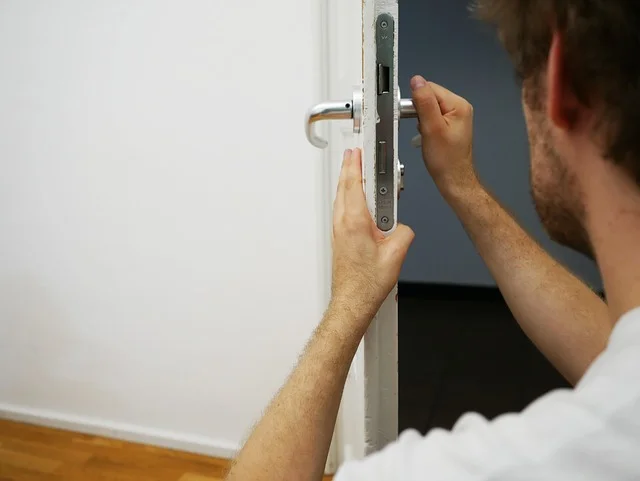

Basic Troubleshooting Techniques
If your lock is not severely jammed, you can try some basic troubleshooting techniques to resolve the issue.
These methods are simple and can often fix minor problems without the need for professional intervention.
Using a Graphite-Based Lubricant
Apply a small amount of graphite-based lubricant to the keyway and insert the key, gently working it back and forth to help distribute the lubricant within the lock.
This can help dislodge dirt and debris and provide smoother operation. Avoid using oil-based lubricants, as they can attract more dirt over time.
Adjusting the Door and Strike Plate Alignment
If your door or strike plate is misaligned, gently loosen the screws on the strike plate and adjust it until the latch can engage and disengage smoothly.
If the door is warped or misaligned, you may need to consult a professional for repairs or adjustments.
Key Extraction Techniques
If your key is stuck or broken inside the lock, use needle-nose pliers or a specialized key extractor tool to carefully remove the key. Be gentle and patient to avoid damaging the lock further.
If you’re unable to extract the key, it’s best to call a professional locksmith for assistance.
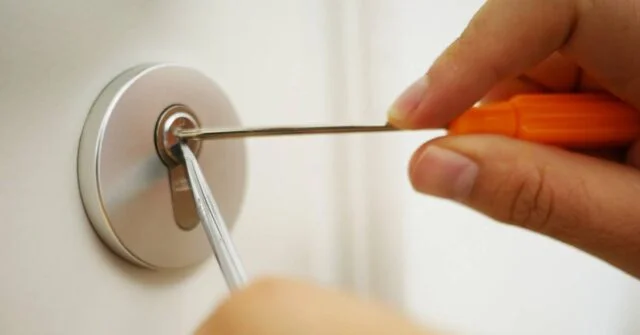

Advanced Lock Repair
If basic troubleshooting techniques don’t resolve the issue, you may need to perform more advanced lock repairs.
These methods involve disassembling the lock, repairing or replacing broken components, and reassembling the lock.
Disassembling the Lock
Remove the lock from the door by unscrewing and detaching the various components. Be sure to keep track of all parts and their order for easier reassembly.
Once the lock is disassembled, inspect the internal components for signs of wear, damage, or debris.
Repairing or Replacing Broken Components
If you find any damaged or worn components, repair or replace them as needed. You can purchase replacement parts from a local hardware store or online.
Ensure that the replacement parts are compatible with your lock model.
Reassembling and Testing the Lock
Reassemble the lock, ensuring all components are correctly positioned and securely fastened. Reinstall the lock on the door and test its operation.
If the lock still does not function properly, you may need to seek professional assistance.
When to Call a Professional Locksmith
While many lock issues can be resolved with DIY methods, some situations require the expertise of a professional locksmith.
It’s essential to know when to call for help to avoid causing further damage to the lock or compromising your security.


Recognizing the Limits of DIY Repair
If you’ve attempted the troubleshooting techniques and advanced lock repairs without success, or if you’re not confident in your ability to perform these tasks, it’s time to call a professional locksmith.
They have the necessary tools, skills, and experience to resolve the issue efficiently and effectively.
Finding a Reputable Locksmith in Australia
When searching for a locksmith, look for one with a good reputation and positive customer reviews.
Ask for recommendations from friends or family members, or search online for local locksmiths with high ratings.
Ensure the locksmith you choose is licensed and insured, as this provides added protection in case of any issues during the repair process.
Understanding Locksmith Services and Costs
Locksmith services can vary in cost depending on the complexity of the issue and the type of lock involved.
Before hiring a locksmith, request a detailed quote for the required services, including any potential additional fees.
This will help you avoid any surprises when it comes to payment and ensure you’re getting a fair price for the work.


Upgrading Your Locks for Improved Security
If your locks are frequently causing problems, it may be time to consider upgrading to more reliable and secure options.
Modern locks offer enhanced security features and can reduce the likelihood of future issues.
High-Security Lock Options
High-security locks, such as deadbolts and mortise locks, provide increased protection against forced entry and lock picking.
These locks often feature reinforced components, complex key systems, and additional security measures to deter burglars and improve your home’s overall security.


Smart Locks and Keyless Entry Systems
Smart locks and keyless entry systems offer convenience and enhanced security by allowing you to control access to your property remotely.
These systems often feature unique access codes, biometric identification, or smartphone integration, reducing the risk of lock issues caused by damaged or lost keys.
Benefits of Upgrading Your Locks
Upgrading your locks can improve your property’s security, reduce the likelihood of future lock issues, and provide peace of mind.
Additionally, high-quality locks can enhance the aesthetic appeal of your doors and add value to your property.

